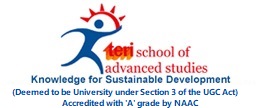
ANNOUNCEMENTS

| Date | News Title | Source |
| 18-July-2025 | 1 in 4 Indian married couples ... | The Indian Express |
| 23-June-2025 | Blended Learning: Driving educ... | The Pioneer |
| 22-June-2025 | All adults overweight in every... | |
| 21-June-2025 | TERI SAS Nurturing Global Sust... | The Interview World (Online) |
| 27-May-2025 | Eco-education trend grows: Sus... | India Today (Online- Education Desk) |
| 25-March-2025 | How water green credits can fu... | Hindustan Times (Opinion) |
| 23-February-2025 | Sustainable biz practices disc... | The Times of India (Online) |
| 21-February-2025 | Sangam fit for bath’, Enviro... | News9 (Online) |
| 12-February-2025 | A role for India in South-Sout... | The Hindu (Online) |
| 02-December-2024 | ICAR Findings Show 34% Decline... | ETV Bharat (Online) |
Human activities release more CO2 into the atmosphere than natural processes can remove, altering the composition of the atmosphere and driving global warming and climate change.
Anand Madhukar and Ananya Mohan
The discourse around climate change has intensified over the past few decades as its worsening impacts become more evident through extreme weather events and record-breaking temperatures. This global phenomenon primarily stems from rising atmospheric carbon dioxide (CO2) levels. Human activities release more CO2 into the atmosphere than natural processes can remove, altering the composition of the atmosphere and driving global warming and climate change.
To mitigate this, we must reduce CO2 concentration by either lowering emissions or capturing and storing them. Carbon Capture, Utilisation, and Storage (CCUS) is a key technology that captures CO2 from industrial emission sources before it enters the atmosphere, helping to decarbonise sectors such as power generation, cement production, and steel manufacturing.
CCUS technologies fall into three main categories: post-combustion, pre-combustion, and oxy-fuel combustion. The post-combustion method captures CO2 after burning fossil fuels, separating it from other gases. Pre-combustion captures CO2 during the gasification of fuel, while in the oxy-fuel combustion process, fuel is burnt in oxygen instead of air, producing CO2 and water vapours, simplifying CO2 capture. Once captured, CO2 can either be utilised or stored. For example, the Enhanced Oil Recovery (EOR) process involved injecting CO2 into oil reservoirs to help extract more oil while storing the CO2 underground.
Captured CO2 can also be transformed into synthetic fuels like methane or methanol, reducing reliance on fossil fuels or used in building materials and accelerating algae production for biofuels. If there are barriers to CO2 utilisation, it can be stored in geological formations by injecting it deep into underground rock formations, such as depleted oil and gas reservoirs or saline aquifers, where it can stay for thousands of years. CO2 can be injected deep into the ocean, where high pressures prevent it from escaping.
CCUS continues to evolve, with innovations and emerging technologies, such as direct air capture (DAC) and bioenergy with carbon capture and storage (BECCS), offering future solutions for reducing atmospheric CO2. DAC removes CO2 directly from the atmosphere, addressing historical emissions, while BECCS aims to deliver negative emissions by absorbing more CO2 than is emitted.
Despite its promise, CCUS faces many challenges limiting its large-scale adoption. The high costs of installation and operation are a significant barrier, as the infrastructure required for CCUS, such as capture equipment and transport pipelines, is expensive. Technical challenges also hinder CCUS adoption. Retrofitting existing industrial facilities with carbon capture technologies is complex.
Additionally, a comprehensive regulatory framework and economic incentives are needed to encourage CCUS deployment. Without policies like carbon pricing or clear regulations on long-term CO2 storage liability, industries can have little motivation to invest in the technology. Public awareness is another issue, and many are concerned about the safety and environmental risks of CO2 storage. Moreover, CCUS competes with the growing renewable energy sector, where solar and wind are becoming more cost-effective.
However, while renewables are essential for decarbonising power generation, CCUS remains vital for hard-to-abate sectors like steel and cement. For countries committed to net zero goals, CCUS can significantly reduce carbon footprints and support sustainable development. In this context, India’s Department of Science and Technology (DST) has been playing a crucial role in advancing CCUS technologies.
DST’s Climate, Energy, and Sustainable Technology (CEST) division has been promoting research and development by funding projects to improve CCUS methods. DST aims to make CCUS technologies more efficient and cost-effective by supporting innovations in materials and processes.
The department also fosters international collaborations, partnering with other countries through initiatives such as Mission Innovation. These partnerships can help India access global expertise and financial resources for CCUS technology development. Recently, the foundation stone of the CO2 to Methanol Pilot Plant with an overall capacity of 1.4 tons per day (TPD) was laid to demonstrate the advancement of indigenous Carbon Capture and Utilisation cutting-edge technologies, marking a significant step towards India’s Panchamrit declaration presented during UNFCCC COP 26. In a nutshell, as the world seeks solutions to limit global warming, the CCUS technologies could be critical to a cleaner, more sustainable future.
(Anand Madhukar is assistant professor and programme coordinator (Climate Science & Policy) at TERI School of Advanced Studies, New Delhi. Ananya Mohan is associate consultant at STENUM Asia)
Plot No. 10, Institutional Area, Vasant Kunj, New Delhi - 110 070, India.
Tel. +91 11 71800222 (25 lines).
Website : www.terisas.ac.in
Email id : registrar@terisas.ac.in
© Copyright © 2025, TERI SAS, All rights reserved.
Visitors No.: 44719220 Since 2023


